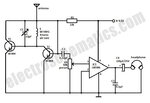garvind25
Full Member level 3
Hi,
I came across this schematic for a FM receiver on the internet (**broken link removed**). I was trying to understand its working.

It is clear that the LC coil will tune to the FM carrier + message signal of the FM station. LM 386 will amplify the message signal demodulated from the tuned signal and drive a speaker /headphone. But I am unable to understand the working of T1, T2, R1, C2 and VR. Most probably, some of these components are demodulating the tuned FM carrier + message signal. But I am not clear of the functioning. Could anyone tell me how the demodulator is working? Which type of FM demodulator is it?
Looking foward to your replies.
Thanks and Regards,
Arvind Gupta.
I came across this schematic for a FM receiver on the internet (**broken link removed**). I was trying to understand its working.

It is clear that the LC coil will tune to the FM carrier + message signal of the FM station. LM 386 will amplify the message signal demodulated from the tuned signal and drive a speaker /headphone. But I am unable to understand the working of T1, T2, R1, C2 and VR. Most probably, some of these components are demodulating the tuned FM carrier + message signal. But I am not clear of the functioning. Could anyone tell me how the demodulator is working? Which type of FM demodulator is it?
Looking foward to your replies.
Thanks and Regards,
Arvind Gupta.